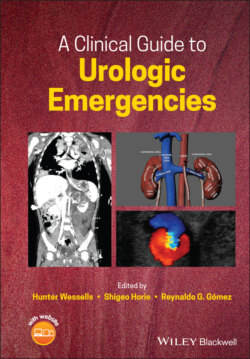Читать книгу A Clinical Guide to Urologic Emergencies - Группа авторов - Страница 19
Management Non‐operative Management
ОглавлениеPatients with high‐grade renal injuries who are hemodynamically stable can be managed non‐operatively, involving hospital admission, intensive care monitoring, bed‐rest, hydration, and serial hematocrit checks [34]. Over time, data have shown that the majority of renal injuries can be safely managed in a non‐operative manner, with the potential benefits of preserving renal function and limiting morbidity [45].
Most stable patients with urinary extravasation can be managed non‐operatively initially, as long as they do not have concern for a renal pelvis or ureteropelvic junction injury. Management may involve bladder drainage in order to facilitate collecting system drainage and/or antibiotics, although evidence is lacking to support these. Urinary extravasation can resolve spontaneously without intervention, with rates of spontaneous resolution near to 90% [46–48]. Guidelines support initial non‐operative management of patients with urinary extravasation, given the possibility of spontaneous resolution and avoiding risks of injury during stent placement, risks of anesthesia, and the possibility of retained stents due to patients being lost to follow‐up [34]. If there is any concern for complications with non‐operative management (such as fever, enlarging urinoma, ileus, infection) or the urinary extravasation is found to be persistent on repeat imaging, ureteral stent placement is indicated. Some of these patients will require additional drainage with a nephrostomy tube and/or perinephric drain [47-48].
The AUA Urotrauma Guidelines suggest that patients who sustain high‐grade injury (AAST IV‐V) that are managed non‐operatively should undergo repeat imaging after 48 hours or earlier, if needed, given the higher risk of complications and possibility of requiring future intervention [34]. In addition, conservatively managed patients who have clinical signs of complications – such as fevers, persistent severe pain, dropping hematocrit, hemodynamic instability, worsening flank or abdominal pain – should also undergo repeat imaging [34].
Repeat imaging may be tailored, based on an individuals' specific injury [49]. A recent analysis of repeat imaging in patients with grade IV and V renal trauma at three Level 1 trauma centers over 19 years (1999–2017) demonstrated that in asymptomatic patients, one in eight patients would need to undergo repeat imaging to identify a patient who needs surgical intervention. The primary goal of repeat imaging is to evaluate for complications and to evaluate clinical deterioration. Hence, it may be more worthwhile to obtain repeat imaging in patients who have signs of bleeding or history of collecting system injury as in this study. Stable patients with grade I–III injuries generally do not require repeat imaging. Repeat imaging with ultrasound instead of CT has also been advocated, based on studies showing that imaging of asymptomatic patients would not have altered clinical decision‐making and concerns that standardized repeat imaging with CT exposes patients to unnecessary radiation exposure, and drives up healthcare costs, and ultrasound has been shown to be an effective alternative for detecting clinically relevant complications [20, 50, 51].
